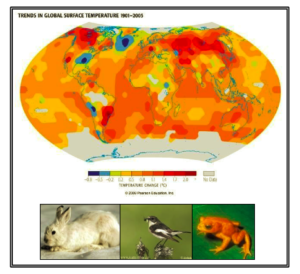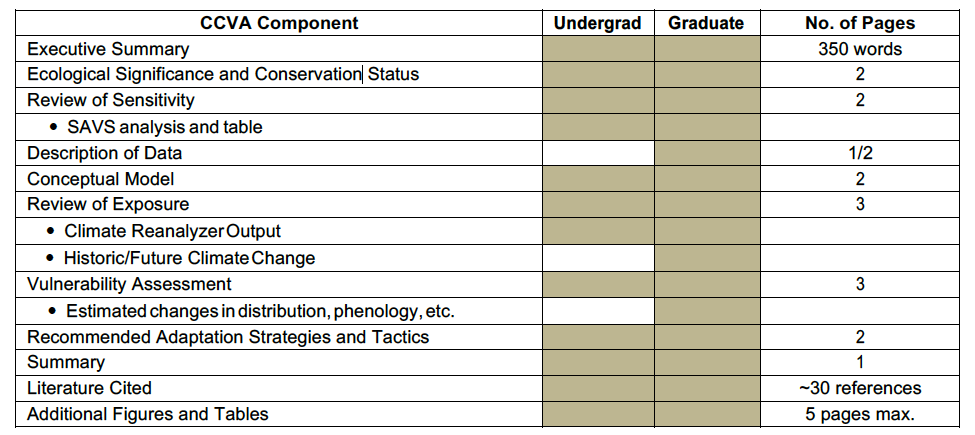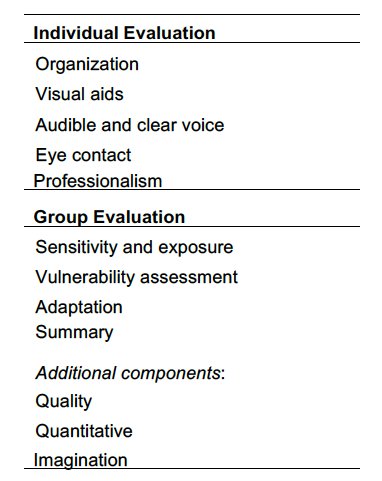PROFESSOR BENJAMINE ZUCKERBERG
 Climate Change Vulnerability is the propensity of a community or species to experience harm from climate change due to its 1) sensitivity to the climate variability, 2) exposure to historic and future climate change, and 3) ability to adapt to novel climate conditions. Assessing the vulnerability of a species or community to the effects of climate change requires an understanding of how climate affects demography, physiology, phenology, habitat, and biotic interactions.
Climate Change Vulnerability is the propensity of a community or species to experience harm from climate change due to its 1) sensitivity to the climate variability, 2) exposure to historic and future climate change, and 3) ability to adapt to novel climate conditions. Assessing the vulnerability of a species or community to the effects of climate change requires an understanding of how climate affects demography, physiology, phenology, habitat, and biotic interactions.
Climate Change Adaptation refers to strategies adopted by agencies to manage species or natural systems based on an awareness that conditions are about to change, or have already changed, and that action is required to reduce their vulnerability through active management and conservation.
The potential ecological impacts of climate change vary for different species and communities. The “effectiveness” of adaptation will thus be species- specific, and can be measured only against a set of objectives. Several concepts related to adaptive management are important for successful adaptation to climate-induced stresses, but none more important than assessing species vulnerability.
The Mission: Climate Change Vulnerability Assessment (CCVA) Numerous state and federal agencies are currently interested in identifying which species are most vulnerable to the impacts of past and future climate change. Principles of climate change vulnerability, adaptation, and mitigation are increasingly becoming necessary components of environmental assessments and wildlife action plans. As part of this exercise, you have been contracted by a government agency to develop a climate change vulnerability assessment (CCVA) for a given species or community.
For undergraduate students, you must choose one of the following species (many of these species have been identified as being particularly susceptible to climate change):
Mink Frog (Rana septentrionalis)
Eastern Massauga Rattlesnake (Sistrurus catenatus)
Greater Prairie Chicken (Tympanuchus cupido)
Common Loon (Gavia immer)
Black-throated Blue Warbler (Setophaga caerulescens)
Black Tern (Chlidonias niger)
Snowshoe Hare (Lepus americanus)
Ermine (short-tailed weasel) (Mustela ermin)
For graduate students, you have more flexibility in what species, community, or region to choose. However, graduate student projects must have all the same components of the CCVA as the rest of the students in the class. There is an increased emphasis on adding a quantitative assessment for capturing aspects of sensitivity and exposure. In the past, students have 1) analyzed preliminary field data, or 2) used existing biological data sets from national databases (http://www.gbif.org/). In some cases, students have conducted reviews of policy and management plans when empirical data were lacking. Because of the diversity of past graduate student projects, I ask that graduate students communicate with me about possible ideas and send me a brief summary of their intentions by September 29th. I am also happy to meet with groups beforehand (please send an email for an appointment). Basic Components of CCVA.
Your CCVAs should be well-crafted and organized. Use Ecology formatting guidelines (http://esapubs.org/esapubs/preparation.htm). You should include a minimum 30 references that are primary literature.
Primary literature is that which contains original data from peer- reviewed journals or scholarly reviews rather than summaries of the findings of others (e.g., textbooks, encyclopedias). Web-based references are appropriate, but only if they are primary references.
Wikipedia is not a primary reference! It is expected the final draft of your CCVA will follow correct guidelines and will go through multiple versions of proofreading for grammatical errors.
A final written report is due during the last week of classes (there’s no Final Exam). The report should be 12-point font, single inch margins, and single spaced. The following tables provides a summary of sections and recommended pages.

Progress Reports
There will be three one-page progress reports. These are opportunities for you to provide a brief overview of your CCVA and receive some additional input.
Progress Report I [DUE DATE: October 6]
Species or community of interest (5 pts)
Brief review of status and ecological significance (5 pts)
Progress Report II [DUE DATE: November 3]
Draft of conceptual model (10 pts)
Brief review of potential sensitives to climate variability (5 pts) SAVS table and summary (5 pts)
Progress Report III [DUE DATE: November 17]
Final draft of conceptual model (10 pts) Draft of review of exposure (5 pts) Draft of adaptation objectives (5 pts)
Group Presentation Guidelines
At the end of the semester, all groups will present their climate adaptation plan. Groups will be evaluated on the following criteria:
